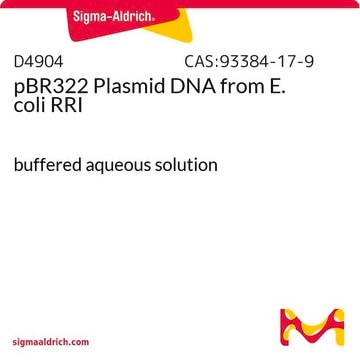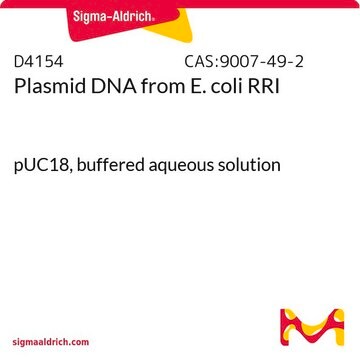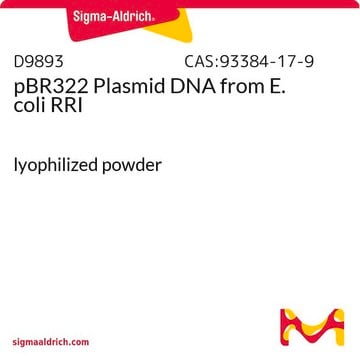D3404
Plasmid DNA from E. coli RRI
pUC19, buffered aqueous solution
About This Item
Prodotti consigliati
Grado
for molecular biology
Forma fisica
buffered aqueous solution
Condizioni di spedizione
dry ice
Temperatura di conservazione
−20°C
InChI
1S/C15H31N3O13P2/c16-13-1-7(20)11(28-13)5-25-32(21,22)31-9-3-15(18)29-12(9)6-26-33(23,24)30-8-2-14(17)27-10(8)4-19/h7-15,19-20H,1-6,16-18H2,(H,21,22)(H,23,24)
AWBASQCACWFTGD-UHFFFAOYSA-N
Cerchi prodotti simili? Visita Guida al confronto tra prodotti
Descrizione generale
Applicazioni
Azioni biochim/fisiol
Foreign DNA inserted at the MCS abolishes the ability to catabolize lactose. Lactose-positive, ampicillin-resistant colonies (host strain containing plasmid) form blue colonies on plates containing ampicillin and X-Gal; lactose-negative, ampicillin-resistant colonies (host strain containing plasmid with foreign DNA inserted at the MCS) form white colonies on this medium. The orientations of the MCS regions in the pUC plasmids are analogous to those of the corresponding M13 phage.
Componenti
Principio
Prodotti correlati
Codice della classe di stoccaggio
10 - Combustible liquids
Classe di pericolosità dell'acqua (WGK)
WGK 1
Punto d’infiammabilità (°F)
Not applicable
Punto d’infiammabilità (°C)
Not applicable
Certificati d'analisi (COA)
Cerca il Certificati d'analisi (COA) digitando il numero di lotto/batch corrispondente. I numeri di lotto o di batch sono stampati sull'etichetta dei prodotti dopo la parola ‘Lotto’ o ‘Batch’.
Possiedi già questo prodotto?
I documenti relativi ai prodotti acquistati recentemente sono disponibili nell’Archivio dei documenti.
disturbance suppression for nanostructure
imaging
Protocolli
Preparation for biodegradable nanoparticles and their use in transfection protocols .
Il team dei nostri ricercatori vanta grande esperienza in tutte le aree della ricerca quali Life Science, scienza dei materiali, sintesi chimica, cromatografia, discipline analitiche, ecc..
Contatta l'Assistenza Tecnica.







